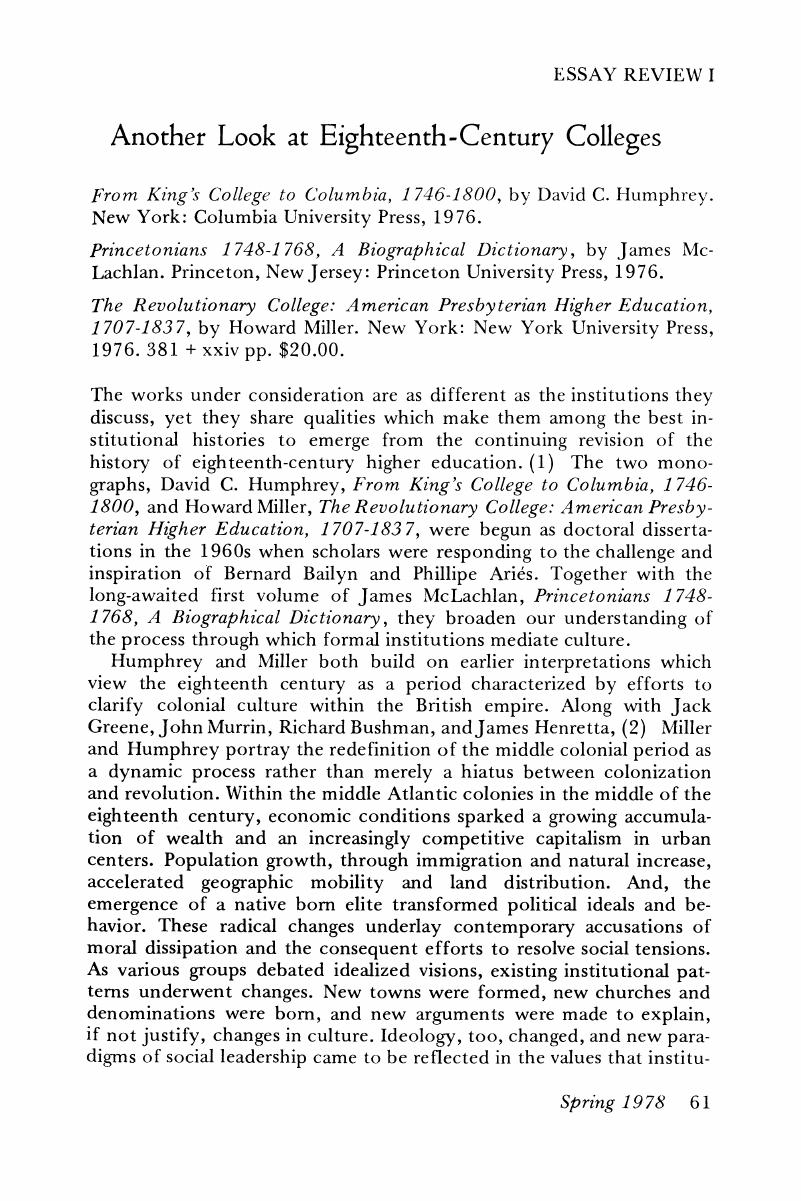No CrossRef data available.
Published online by Cambridge University Press: 24 February 2017

1. Herbst, Jurgen discusses these patterns in “American College History: Re-Examination Underway,” History of Education Quarterly 14 (1974): 259–266.Google Scholar
2. For examples, see: Greene, Jack P., “Search for Identity: An Interpretation of the Meaning of Selected Patterns of Social Response in Eighteenth-Century America,” Journal of Social History, 3 (1970): 189–220; Murrin, John M., “The Legal Transformation: The Bench and Bar of Eighteenth-Century Massachusetts in Colonial America: Essays in Politics and Social Development , ed., Katz, Stanley N. (Boston, 1971), pp. 451–450; Bushman, Richard, From Puritan to Yankee, Character and the Social Order in Connecticut, 1690–1765 (Mass., 1967); Henretta, James A., The Evolution of American Society, 1700–1815 (Mass., 1973).Google Scholar
3. Though most mention Cooper, few have actually focused on him. The exceptions are: Jones, Leroy, “Myles Cooper, LL.D., Second President of King's College, 1763–1777,” Columbia University Quarterly I (1898–99): 347–357; Vance, Clarence Hayden, “Myles Cooper, M.A., DCL., LL.D, Second President of King's, Now Columbia University, New York City,” in ibid., 22 (1930): 261–286.Google Scholar
4. Cremin, Lawrence R., American Education: The Colonial Experience 1607–1783 (New York, 1970), p. 510.Google Scholar
5. See Norton, Mary Beth, The British-Americans: The Loyalist Exiles in England, 1774–1789 (Boston, 1972), pp. 32–34.Google Scholar
6. Potts, David B., “American Colleges in the Nineteenth Century: From Localism to Denominationalism,” History of Education Quarterly XI (1971): 363–380; Naylor, Natalie A., “The Ante-Bellum College Movement: A Reappraisal of Tewksbury's The Founding of American Colleges and Universities,” ibid., XII (1973): 261–275. Also see Potts' recent essay, “‘College Enthusiasm!’ As Public Response, 1800–1860,” Harvard Education Review 47 (1977): 28–43. On the distinction between denominational control and religious influence for these Presbyterian schools see Geiger, C. Harve, The Program of Higher Education of the Presbyterian Church in the United States of America (Iowa, 1940), pp. 30–33.Google Scholar
7. A number of works speak to these considerations. Especially pertinent is Wood, Gordon, The Creation of the American Republic, 1776–1787 (Chapel Hill, 1969); Howe, John, “Republican Thought and the Political Violence of the 1790's,” American Quarterly 19 (1967): 147–165; Herbst, Jurgen, “The American Revolution and the American University,” Perspectives in American History X (1976): 279–357.Google Scholar
8. This is discussed also in Come, Donald R., “The Influence of Princeton on Higher Education in the South Before 1825,” William and Mary Quarterly, 3rd. Series, 2 (1945): 359–396.Google Scholar
9. This builds on the work of Allmendinger, David F. Jr., “The Dangers of Ante-Bellum Student Life,” Journal of Social History 7 (1973): 80, 84–95 fn. 14; Paupers and Scholars: The Transformation of Student Life in Nineteenth-Century New England (New York, 1975), chapter 1.Google Scholar
10. Quantitative investigations of students are discussed in Potts, David B., “Students and the Social History of American Higher Education,” History of Education Quarterly, 15 (1975): 317–322.Google Scholar